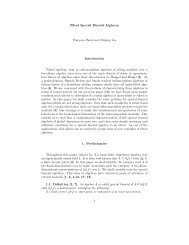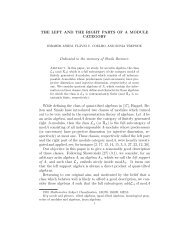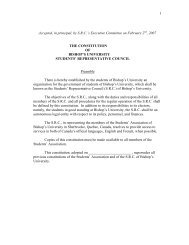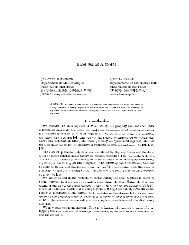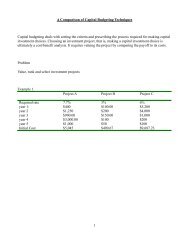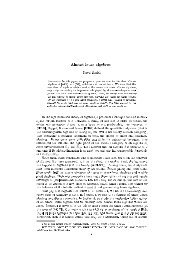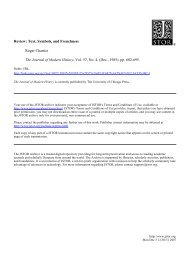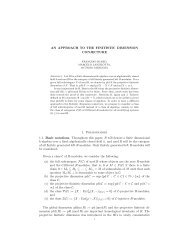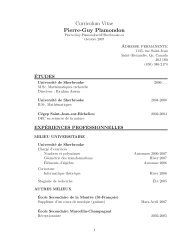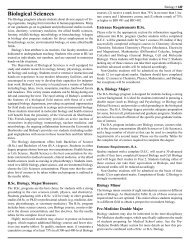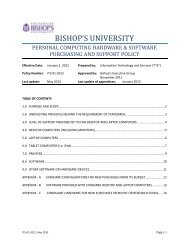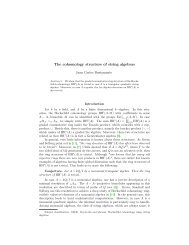Hochschild Cohomology and Representation-finite Algebras Ragnar ...
Hochschild Cohomology and Representation-finite Algebras Ragnar ...
Hochschild Cohomology and Representation-finite Algebras Ragnar ...
You also want an ePaper? Increase the reach of your titles
YUMPU automatically turns print PDFs into web optimized ePapers that Google loves.
18<br />
Proof. Let δ ∈ Der R (A) be a derivation <strong>and</strong> f ∈ Hom A e(Ω A ,A) the corresponding<br />
map; see Lemma 3.1.(1). For each i, themapf defines an exact commutative<br />
diagram:<br />
M i⊗ Aj A<br />
M i ⊗ A ω A : 0 −−−−→ M i ⊗ A Ω A −−−−−−→ Mi ⊗ A −−−−−−→ Mi⊗AµA<br />
M i −−−−→ 0<br />
⏐ ∥<br />
⏐<br />
M i⊗ Af↓ σ i<br />
⏐↓ ∥∥<br />
η i : 0 −−−−→ M i −−−−→ E i −−−−→ M i −−−−→ 0.<br />
Summing up yields the following exact commutative diagram:<br />
M⊗ Aj A<br />
M⊗ Aµ A<br />
M ⊗ A ω A : 0 −−−−→ M ⊗ A Ω A −−−−−→ M ⊗ A −−−−−→ M −−−−→ 0<br />
⏐ ∥<br />
⏐<br />
M⊗ Af↓ ⊕ ⏐↓ ∥∥<br />
iσ i<br />
⊕ i η i : 0 −−−−→ M −−−−→ ⊕ i E i −−−−→ M −−−−→ 0.<br />
Therefore, χ M ([δ]) = [⊕ i ζ i ] ∈ ⊕ n<br />
i=1 Ext1 A (M i,M i ). This completes the proof of the<br />
lemma.<br />
In our main application, we shall consider the case where M is a right A-module<br />
<strong>and</strong> B =End A (M), whence M is endowed with the canonical B-A-bimodule structure.<br />
Moreover, there exists a morphism of B-A-bimodules ρ : A → End B (M),<br />
where the map ρ(a) fora ∈ A is given by ρ(a)(x) =xa, for all x ∈ M. Recall that<br />
M is a faithfully balanced B-A-bimodule if ρ is an isomorphism.<br />
3.5. Theorem. Let A be an algebra over a commutative ring R. Let M be<br />
arightA-module <strong>and</strong> set B =End A (M). Assume that M is a faithfully balanced<br />
B-A-bimodule with Ext 1 B (M,M) =0. Then there exists an exact sequence<br />
0 −→ HH 1 (B) −→ HH 1 (A) −→ χM<br />
Ext 1 A (M,M)<br />
of R-modules. Moreover, if M = ⊕ n i=1 M i is a decomposition of right A-modules,<br />
then the image of χ M lies in the diagonal part ⊕ n i=1 Ext1 A(M i ,M i ).<br />
Proof. By hypothesis, HH 1 (A, ρ) :HH 1 (A) → HH 1 (A, End B (M)) is an isomorphism.<br />
Furthermore, the map g A in Proposition 3.2.(1) is an isomorphism since<br />
Ext 1 B (M,M) =0. Thusγ = g A ◦ HH 1 (A, ρ) is an isomorphism. Set c = γ −1 ◦ g B .<br />
It follows from the definition of χ M that the diagram<br />
0 −−−−→ HH 1 c<br />
(B) −−−−→ HH 1 χ M<br />
(A) −−−−→ Ext<br />
1<br />
A (M, M)<br />
⏐<br />
∥<br />
γ↓ ∼ =<br />
∥<br />
0 −−−−→ HH 1 (B)<br />
g B<br />
−−−−→ Ext<br />
1<br />
B o ⊗A (M,M)<br />
f B<br />
−−−−→ Ext<br />
1<br />
A (M, M)<br />
is commutative. By Proposition 3.2.(2), the lower row is exact, <strong>and</strong> hence the<br />
upper row is an exact sequence as desired. The last part of the theorem follows<br />
from Lemma 3.4. This completes the proof.<br />
For a right A-module, denote by add(M) the full subcategory of the category of<br />
right A-modules generated by the direct summ<strong>and</strong>s of direct sums of <strong>finite</strong>ly many<br />
copies of M. WecallM an A-generator if A lies in add(M). We shall now study the



